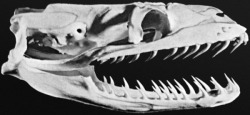
Aglyphous ("lacking grooves") snakes have no specialized teeth - each tooth is more or less the same in shape and often in size. When some teeth are larger than others, as is sometimes the case in bird eaters such as Corralus, the enlarged teeth are merely "scaled up", and are otherwise identical. Aglyphous snakes are non-venomous, and can be found in numerous families.
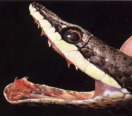
Opisthoglyphous snakes have fangs at the
back of their mouth (opistho means behind).
These fangs usually have a ‘groove’. When the snake is holding or biting into prey, venom flows down the groove and into the prey’s wound. They are mostly harmless or mildly venomous
to humans.
The only Australian snakes that have grooved fangs are the brown tree snake (Boiga irregularis) and some freshwater snakes in northern Australia.
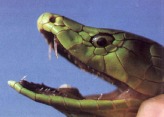
Proteroglyphous snakes have small fangs fixed in place at the front of their mouth. These snakes’ fangs do not move and are smaller than other types of fangs, so the snake does not puncture its lower lip when it closes its mouth. Fang size ranges from 3 to 10 millimetres long, depending on the size and species of snake.
When these snakes bite they hang on and ‘chew’ into the prey’s flesh to release venom. These are some of the deadliest snakes in the world. Examples of proteroglyphous snakes are cobras, taipans, coral snakes and sea snakes.

Solenoglyphous snakes have hollow fangs that are located at the front of the snake’s mouth. They are hinged, so they can swing forward, stab prey and quickly inject venom before withdrawing their fangs to avoid being injured by the struggling prey.The fangs fold back into a pouch on the roof of the snake’s mouth until they are needed again. These snakes can also open their mouth almost 180 degrees with the fangs extended straight out.Solenglyphous snakes can rotate each fang independently, but when they swing forward
to strike, the fangs are erected together.
When proteroglyphous and solenglyphous snakes lose their fangs, they have five to seven replacement fangs waiting in their gums behind and above the original fang. Depending on the species of snake and how healthy or injured it is, fangs are replaced every ten days to ten weeks.
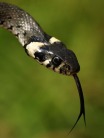
Colubridae (Colubrids) :
About 2000 species. Make up 2/3 of total snakes.
Eg: Garter snakes, Boomslangs, African Bird snake.
Lives through out the world. The different species vary greatly in appearance and ways of life.

Typhlopidae (Blind Snakes) :
About 200 species; burrows the underground and eats ants and earthworms. Looks like earthworms. About 90 cm in length; Eyes covered with head scales. Lives in tropical and sub-tropical regions.

Anomalepididae (Primitive B.S) :
Small worm like snake which lives in rain forests of central and south america; eats small insects and worms. Closely related to Blind snakes. about 20 species known.
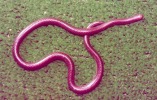
Leptotyphlopidae (Thread Snakes) :
About 50 species known. Closely related to the Blind Snakes. Only differences are
B.S : Tooth in upper jaws.
TS : Tooth in lower jaws.
Lives in Africa, Southern Asia, S.W.N America; tropical areas of Central and S. America.

Boidae (Biods) :
Include the largest snakes like Anacondas, Pythons and Boas. about 100 species; large and stout bodies. However some are less than 90 cm. Have external vestigal organs. Seen in tropical and subtropical areas.
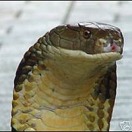
Elapidae (Elapids) :
About 200 species. Short; have non movable fangs (modified venom tooth). Front fanged snakes; All highly venomous. No elapids live in Europe.
Eg: Coral snakes, Australian Black snakes, Death Adders, Tiger Snakes, King Cobras, Cobras.

Hydrophiidae (Sea Snakes) :
About 50-60 species. Related to Elapids. About 90-120 cm long. Body flattened sideways (adapted to swimming). Topical areas of the Indian and Pacific oceans. Seen in depths less than 50 m. Give birth to Young ones.
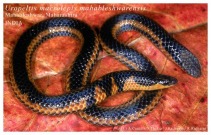
Uropeltidae (Shield Tailed) :
About 25 species. Live in Southern India and Sri-Lanka. Have highly pointed or wedge shaped snout. Blunt tail and smooth scales.
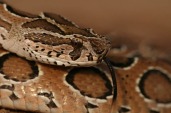
Viperidae (Vipers) :
Have long hollow fangs (Movable), Highly venomous. Head triangular and keeled (in majority). Front movable fangs. Longer fangs.
The new specimen was found by a group of three men from the Arunachal Pradesh and its surrounding areas.. Feared by the local people.. (Bad Omen).. Its not a true viper.. its a pit viper.. which has similarities b/w the Jerdon's Pit Viper (Protobothrops jerdonii) and Kaulback's lance-headed pitviper(Protobothrops kaulbacki)...
The Male and female specimen were examined and it was seemed that these snakes suicided in the hands of the herpetologist. Killing themselves with their own fangs.The snake specimen is yet to be named..
From the NEWS :
A deadly hiss has emanated from the country’s easternmost state, Arunachal Pradesh.A three-member team discovered what could be a new species of pit viper snake, from the remote Sango area in Papum Pare district of the state.Herpetologist B.B. Bhatt from the state Forest Research Institute, Arunachal Pradesh, Pune-based herpetologist Ashok Captain and Kedar Bhide, a Mumbai-based wildlife documentary filmmaker told The Telegraph that two serpents belonging to the “new species” were caught after a one-year hunt.Barta, as the local Nyishi tribesmen call the six-foot-something reptile, is the most-feared creature among the tribes in Arunachal Pradesh.According to Nyishi folklore, sighting of a barta, meaning the deadliest of all the snakes, is a bad omen.The finding of “a new species of pit viper snake”, however, has created a flutter among the country’s herpetologists.“Going by the colour, count and patterns of the newly-found snakes which differ from Protobothrops kaulbacki, another species of pit viper snake spotted by Ronald Kaulback in the forests of Upper Myanmar in 1940, it can be said that it is probably a new species found never before in the forests.Although at a glance they look similar to the snake found in Myanmar, their features differ from Protobothrops kaulbacki. The blood samples of the snakes have been sent for DNA tests to a Hyderabad-based laboratory this month. We are awaiting an official confirmation,” Bhatt told The Telegraph.Bhatt, who has documented 76 of the 140 species of snakes found in Arunachal Pradesh, said the most striking feature of the newly-found species was its egg-producing capacity. It can lay a clutch of 20 to 30 eggs - a phenomenon hitherto unknown to scientists.“This type of snakes are found at an altitude of above 1,000 meters and prey on frogs, fish and rats. But they are not known to lay eggs. Another striking feature are their pits, which are much larger than those of the other snakes of the pit viper family. The species has been so named because an organ in its body consists of pits. It is just behind the nostrils and covered with a temperature-sensitive membrane. Some pit vipers may also use these organs to find cool refuge from inhospitable daytime temperature,” Bhatt said.The herpetologists caught a pair of snakes, a male and a female, but the reptiles chose to escape death at the hands of the humans and killed themselves by using their own fangs, much to the surprise of Bhatt who has been watching reptile behaviour for the last seven years in the forests of the Northeast and north India. According to Bhatt, this sheds new light on the strange behavioural pattern of the species, so long unknown to herpetologists.“Pit vipers have long, hollow, erectile fangs that are folded back against the roof of the mouth except when the snakes are striking. Once the fangs are out, it becomes difficult to fold back those organs and unable to cope with the situation they might have killed themselves,” Bhatt explained.













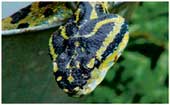

 RSS Feed
RSS Feed
